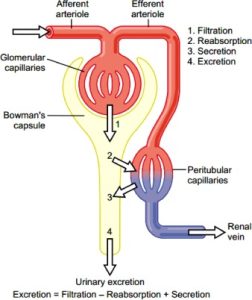Chapter 13. The Urinary System
13.3 Physiology of Urine Formation: Overview
Learning Objectives
By the end of this section, you will be able to:
- generally define the processes of glomerular filtration, reabsorption, and secretion;
- compare and contrast the composition of blood plasma and glomerular filtrate; and
- distinguish between renal secretion and renal excretion.
As introduced in the previous section, the nephron utilizes three specific processes to keep the plasma constituents at homeostatic levels: filtration, reabsorption, and secretion (Figure 13.3.1). Urine is the waste product produced as a results of these activities. In this section, a general overview of these processes is presented, with detailed explanations found in subsequent sections in this chapter.

Glomerular Filtration
The entire plasma volume (about 3 L) is filtered 60 times per day. Glomerular filtration occurs as blood in the glomerulus is filtered into the glomerular capsule, producing the filtrate. The filtrate is similar in composition to plasma, except the filtrate formed by healthy kidneys contains no blood cells and little to no proteins. This filtrate produced then becomes highly modified along its route through the nephron by the following processes, resulting in urine formation at the end of the collecting duct.
Tubular Reabsorption
In tubular reabsorption, substances move from the filtrate into the blood: the overall function of reabsorption is to reclaim substances that the body needs back into the blood. As the filtrate travels along the length of the nephron, the cells lining the tubules selectively, and often actively, take substances from the filtrate and move them out of the tubule into the blood. Recall that the glomerulus is simply a filter and anything suspended in the plasma that can fit through the holes in the filtration membrane can end up in the filtrate. This includes physiologically important molecules such as water, sodium, chloride, and bicarbonate as well as nutrients such as glucose and amino acids. These molecules would be lost in the urine if not reclaimed by the tubule cells. The nephron tubules reabsorb all of the glucose and amino acids and up to 99% of the water and important ions lost due to glomerular filtration. The filtrate that is not reabsorbed becomes urine at the base of the collecting duct.
Tubular Secretion
Tubular secretion occurs mostly in the PCT and DCT where substances are moved from the blood into the filtrate in the lumen of the tubule. Secretion usually removes substances from the blood that are too large to be filtered (e.g. certain medications, toxins) or those that are in excess in the blood (e.g. H+, K+). Substances secreted into the tubule are excreted from the body in the urine.
Section Review
The entire plasma volume is filtered through the kidneys about 60 times per day, and 99% of the water filtered is recovered. Glomerular filtration occurs as blood in the glomerulus is filtered into the glomerular capsule. The result is a filtrate lacking blood cells and most proteins. Tubular reabsorption is the active and passive movement of substances from the filtrate back into the blood. Reabsorption enables substances to be retained in the body and not excreted in the urine. Tubular secretion is the active transport of substances from the blood into the filtrate. This enables substances too big to be filtered or those that are in excess to be eventually excreted in the urine.
Review Questions
Reference
Jaddi, N. S., Alvankarian, J., & Abdullah, S. (2017). Kidney-inspired algorithm for optimization problems. Communications in Nonlinear Science and Numerical Simulation 42:358–369.
This work, Human Physiology, is adapted from Anatomy & Physiology by OpenStax, licensed under CC BY. This edition, with revised content and artwork, is licensed under CC BY-SA except where otherwise noted.
Images from Anatomy & Physiology by OpenStax are licensed under CC BY except where otherwise noted.
Access the original for free at OpenStax.
Report an Error
Did you find an error, typo, broken link, or other problem in the text? Please follow this link to the error reporting form to submit an error report to the authors.
